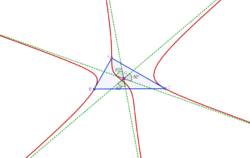McCay cubic
In Euclidean geometry, the McCay cubic (also called M'Cay cubic[1] or Griffiths cubic[2]) is a cubic plane curve in the plane of a reference triangle and associated with it. It is the third cubic curve in Bernard Gilbert's Catalogue of Triangle Cubics and it is assigned the identification number K003.[2]
Definition
The McCay cubic can be defined by locus properties in several ways.[2] For example, the McCay cubic is the locus of a point P such that the pedal circle of P is tangent to the nine-point circle of the reference triangle △ABC.[3] The McCay cubic can also be defined as the locus of point P such that the circumcevian triangle of P and △ABC are orthologic.
Equation of the McCay cubic
The equation of the McCay cubic in barycentric coordinates [math]\displaystyle{ x:y:z }[/math] is
- [math]\displaystyle{ \sum_{\text{cyclic}}(a^2(b^2+c^2-a^2)x(c^2y^2-b^2z^2))=0. }[/math]
The equation in trilinear coordinates [math]\displaystyle{ \alpha : \beta : \gamma }[/math] is
- [math]\displaystyle{ \alpha (\beta^2 - \gamma^2)\cos A + \beta (\gamma^2 - \alpha^2)\cos B + \gamma (\alpha^2 - \beta^2)\cos C = 0 }[/math]
McCay cubic as a stelloid
A stelloid is a cubic that has three real concurring asymptotes making 60° angles with one another. McCay cubic is a stelloid in which the three asymptotes concur at the centroid of triangle ABC.[2] A circum-stelloid having the same asymptotic directions as those of McCay cubic and concurring at a certain (finite) is called McCay stelloid. The point where the asymptoptes concur is called the "radial center" of the stelloid.[4] Given a finite point X there is one and only one McCay stelloid with X as the radial center.
References
- ↑ Weisstein, Eric W. "M'Cay Cubic". Wolfram Research, Inc.. https://mathworld.wolfram.com/MCayCubic.html.
- ↑ 2.0 2.1 2.2 2.3 Bernard Gilbert. "K003 McCay Cubic = Griffiths Cubic". Bernard Gilbert. https://bernard-gibert.pagesperso-orange.fr/Exemples/k003.html.
- ↑ John Griffiths. Mathematical Questions and Solutions from the Educational Times 2 (1902) 109, and 3 (1903) 29.
- ↑ Bernard Gilbert. "McCay Stelloids". Bernard Gilbert. https://bernard-gibert.pagesperso-orange.fr/files/Resources/stelloidsK003.pdf.
 |



